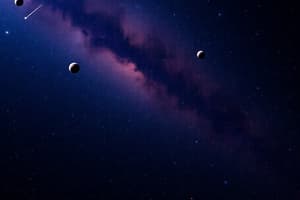Podcast
Questions and Answers
What is the term for when Earth is located between the Moon and the Sun, and the whole surface of the Moon is visible to us on Earth?
What is the term for when Earth is located between the Moon and the Sun, and the whole surface of the Moon is visible to us on Earth?
- Waxing crescent
- Full moon (correct)
- First quarter moon
- New moon
In what phase of the Moon would you see only half of the Moon illuminated by the Sun from Earth?
In what phase of the Moon would you see only half of the Moon illuminated by the Sun from Earth?
- New moon
- Waning crescent
- Last quarter moon (correct)
- Waxing gibbous
What is the Sun classified as in relation to other stars outside our solar system?
What is the Sun classified as in relation to other stars outside our solar system?
- Asteroid
- Moon
- Planet
- Star (correct)
What causes the full moon phase to occur?
What causes the full moon phase to occur?
Which celestial body is responsible for most of the energy that reaches our planet?
Which celestial body is responsible for most of the energy that reaches our planet?
What causes different constellations to be visible at different times of the year?
What causes different constellations to be visible at different times of the year?
How often does the Moon complete one full trip around Earth?
How often does the Moon complete one full trip around Earth?
Why does the Moon reflect light?
Why does the Moon reflect light?
What causes the patterns in the amount of daylight cities receive throughout the year?
What causes the patterns in the amount of daylight cities receive throughout the year?
How do constellations appear to move in the sky?
How do constellations appear to move in the sky?
Flashcards are hidden until you start studying
Study Notes
Objects in the Sky
- By observing objects in the sky, we can find patterns such as day and night, seasons, phases of the Moon, and constellations.
The Sun
- The Sun is a star, an extremely hot, dense mass of gases that burns to give off radiation, including light and heat.
- Most of the energy that reaches our planet comes from the Sun.
- The Sun is responsible for many patterns and cycles in our solar system.
The Moon
- The Moon cycles through phases about once a month.
- A full moon occurs when Earth is located between the Moon and the Sun, making the whole surface of the Moon visible to us on Earth.
- A new moon occurs when the Moon is in between the Sun and Earth, making the side of the Moon facing us dark.
- The Moon phases include new moon, waxing crescent, first quarter moon, waxing gibbous, full moon, waning gibbous, last quarter moon, and waning crescent.
- The Moon is always half-illuminated by the Sun.
Constellations
- A constellation is a set of stars that makes a pattern when viewed in relation to each other.
- The International Astronomical Union (IAU) has named 88 constellations, including Ursa Major, Ursa Minor (the Little Dipper), Orion, Hercules, and Pegasus.
- Constellations appear to move in the sky from east to west due to Earth's rotation.
Earth's Rotation and Orbit
- Earth rotates on its axis, causing day and night.
- Earth revolves around the Sun, causing different stars to be visible at different times of the year due to its orbit.
- The Sun's gravity holds the planets and other objects in the solar system in orbit.
Additional Facts
- The Moon orbits around Earth, completing one full trip approximately every month.
- The Moon rotates on an axis, and its illuminated portion visible from Earth varies as it revolves around Earth.
Studying That Suits You
Use AI to generate personalized quizzes and flashcards to suit your learning preferences.




